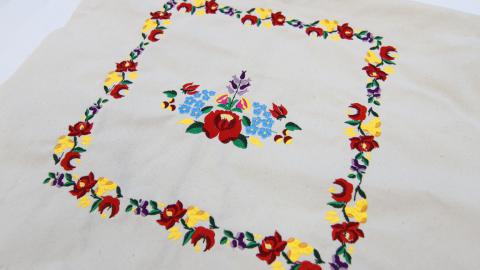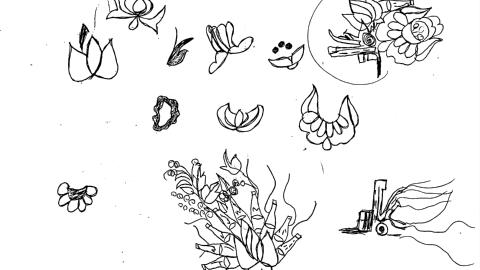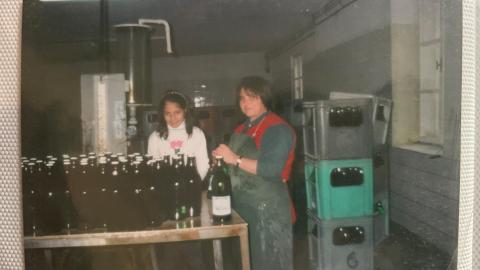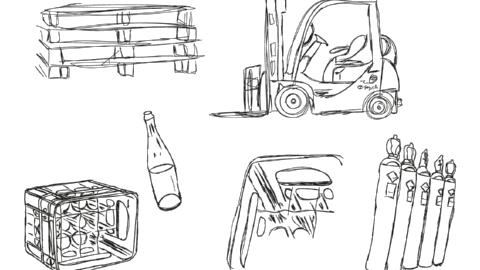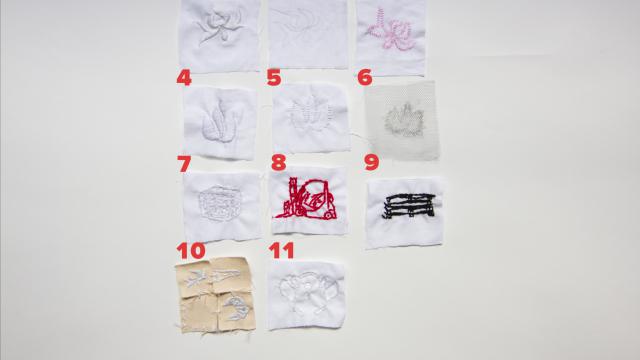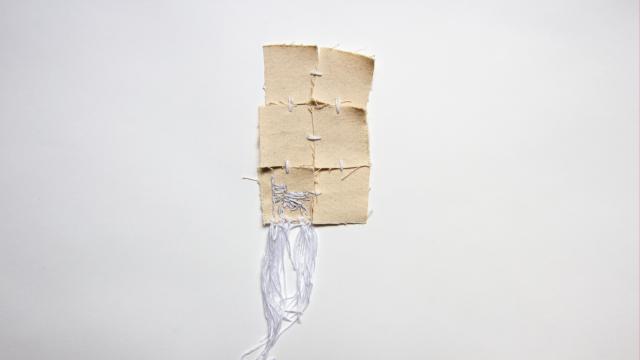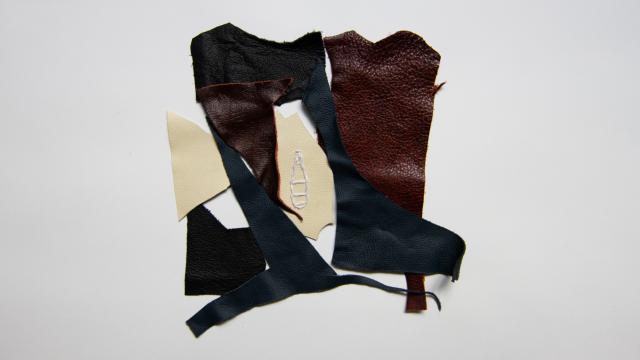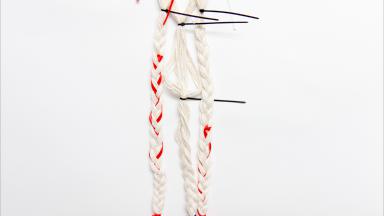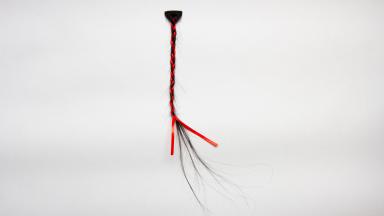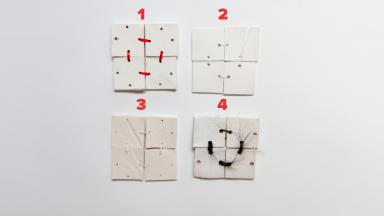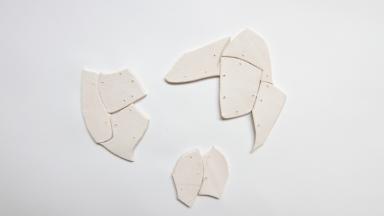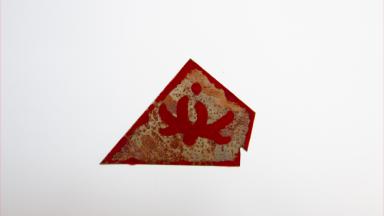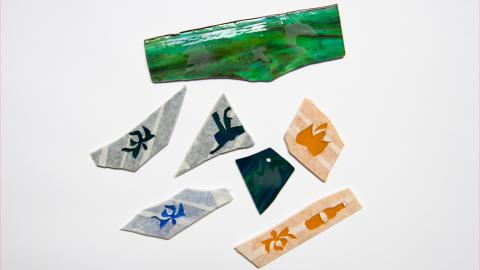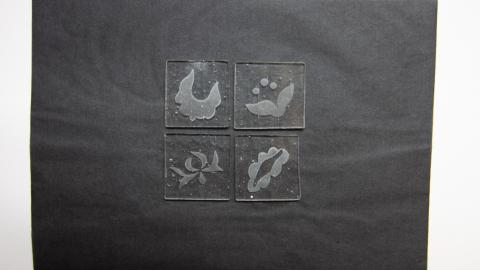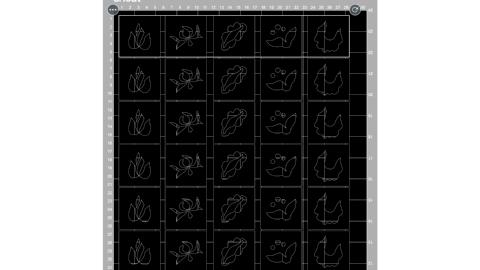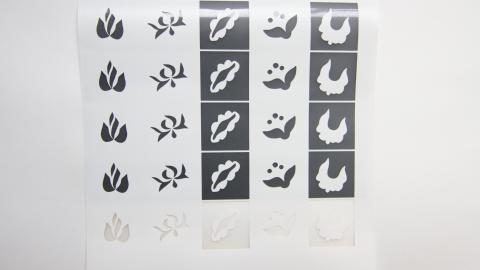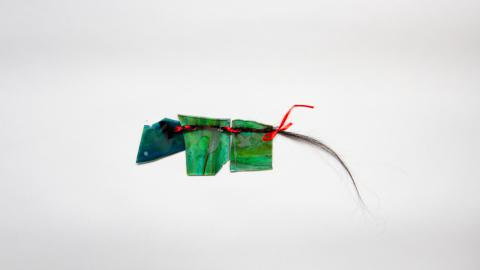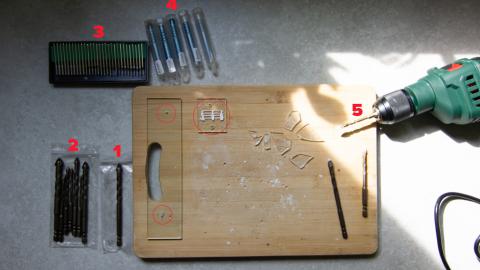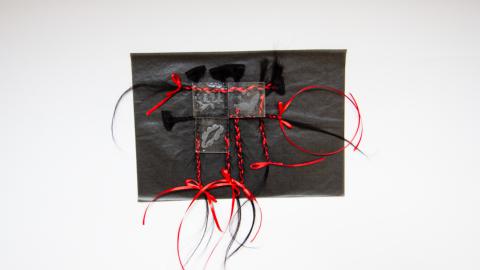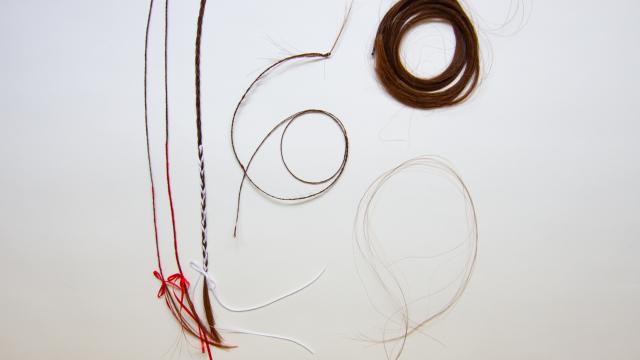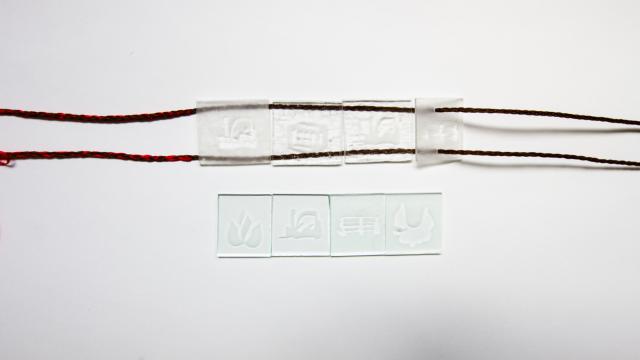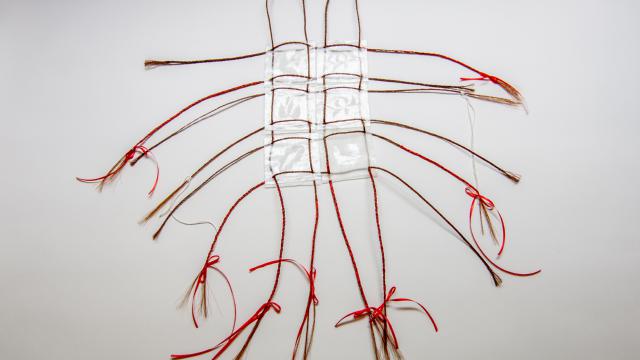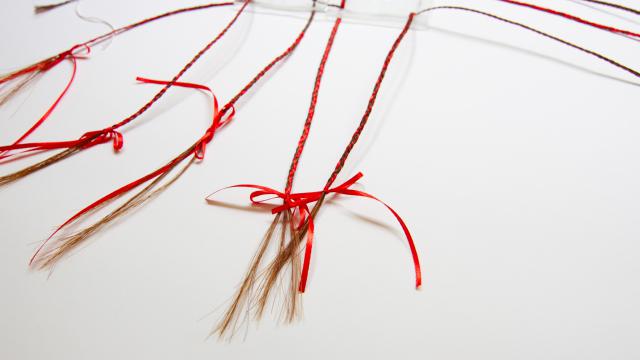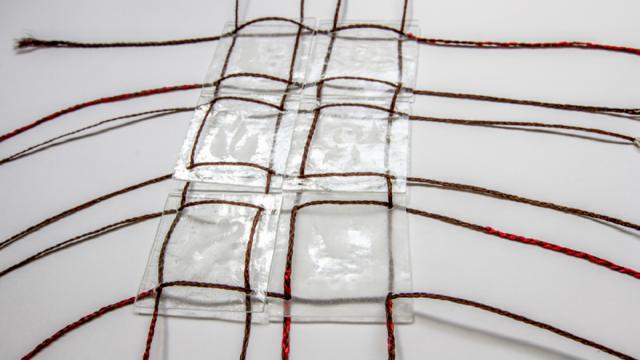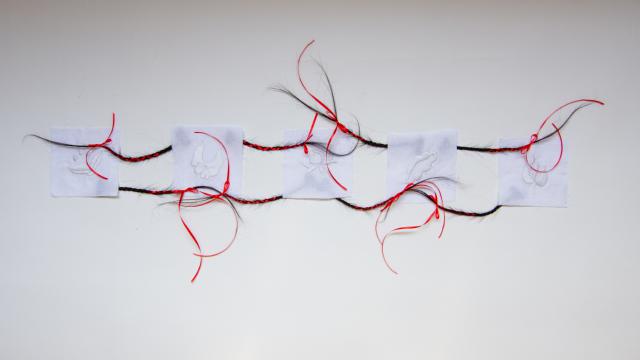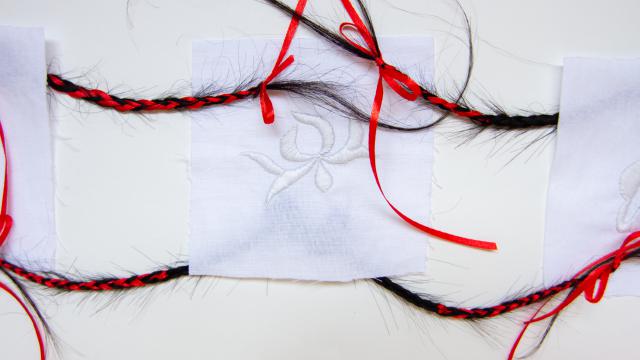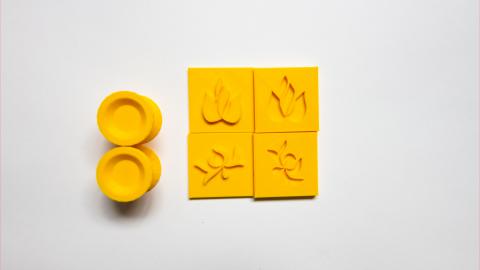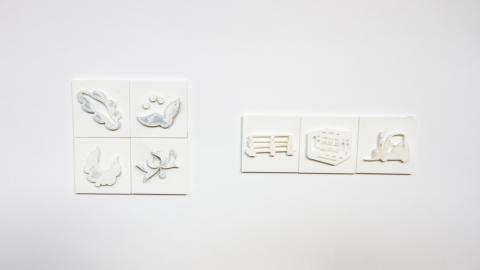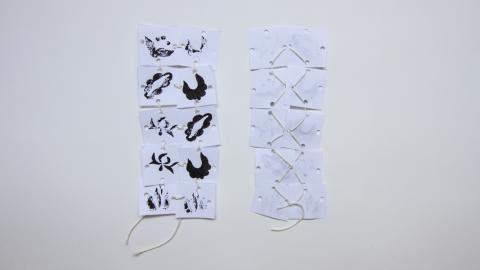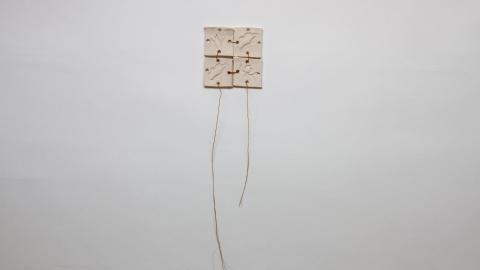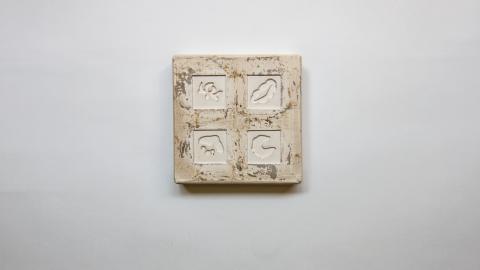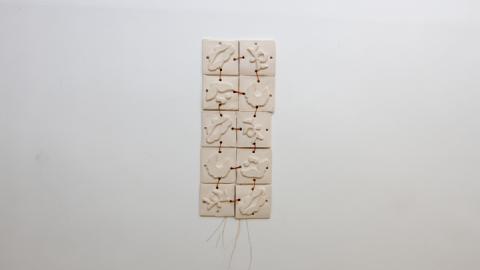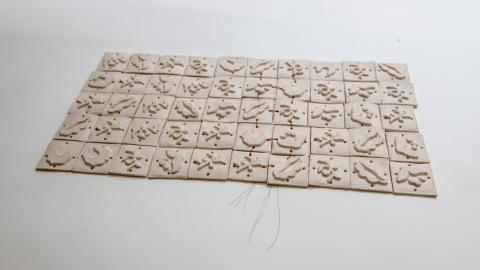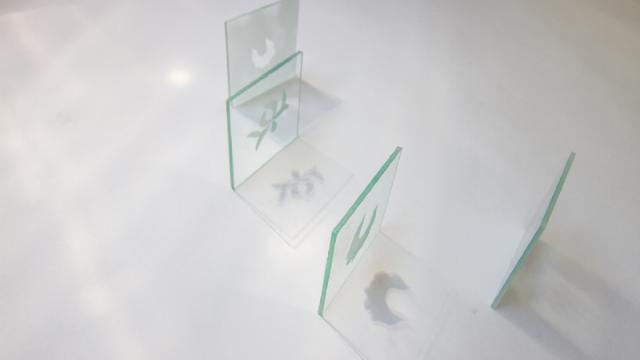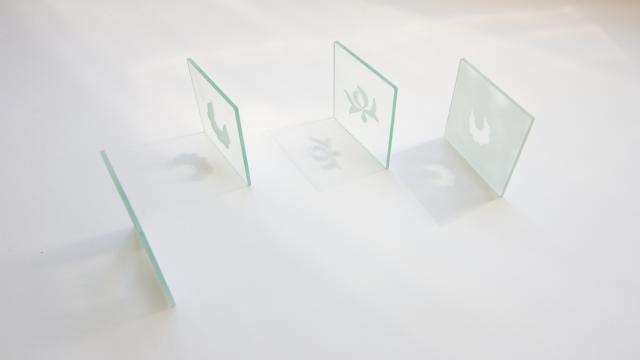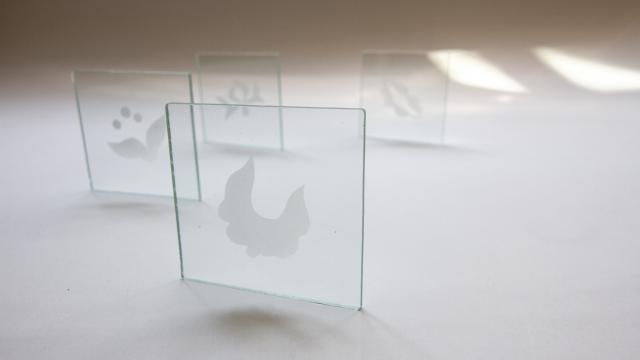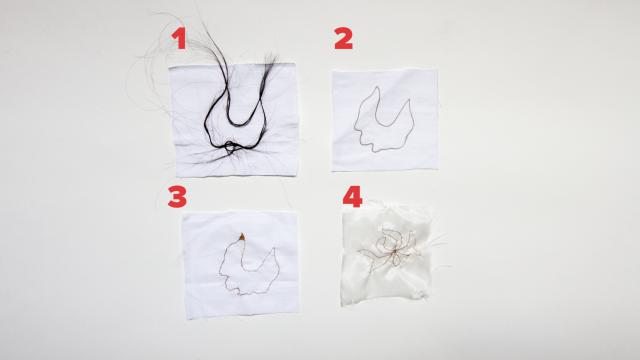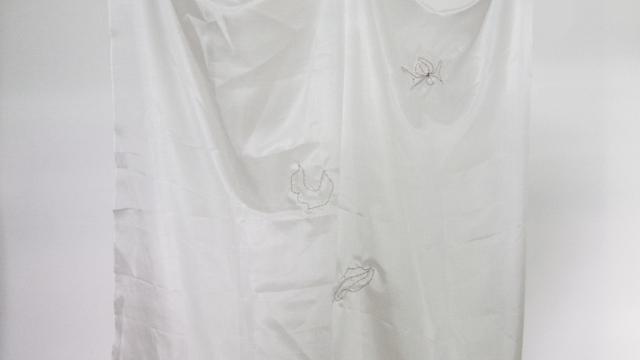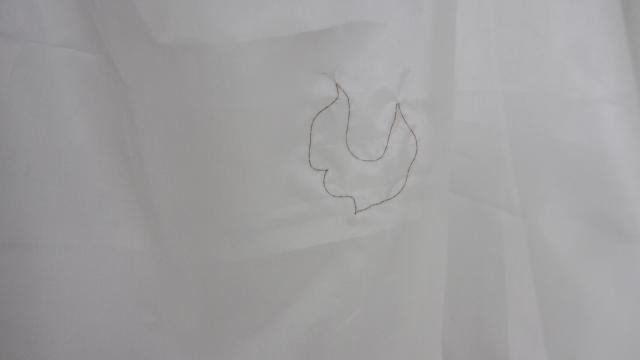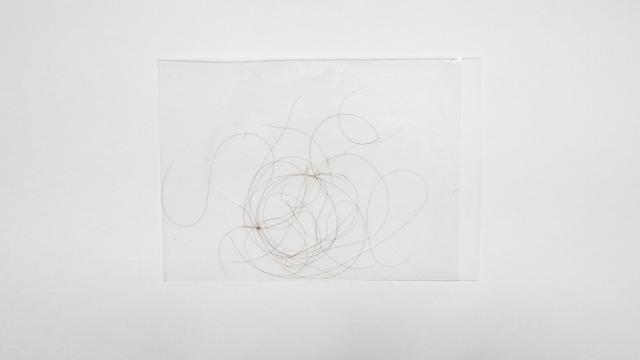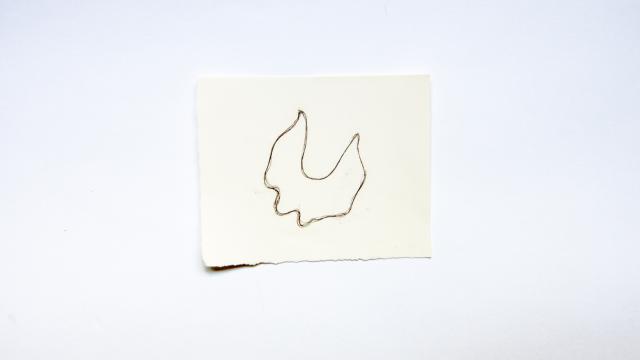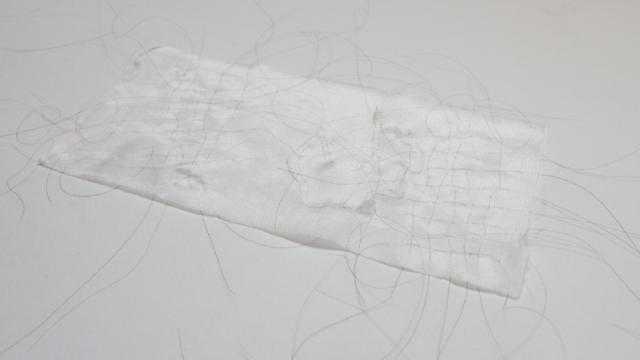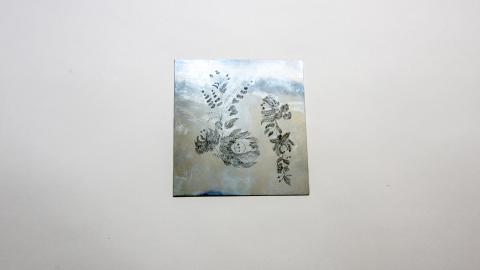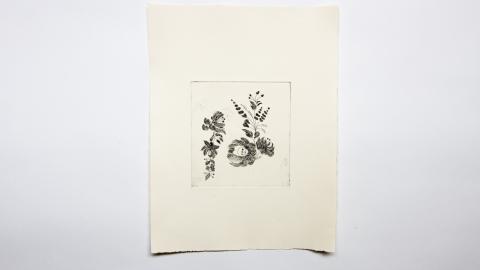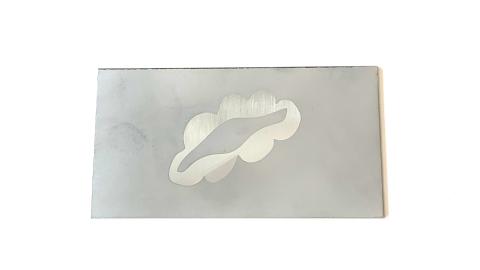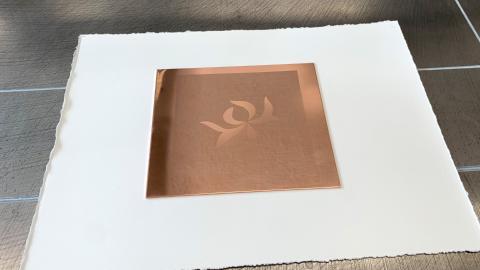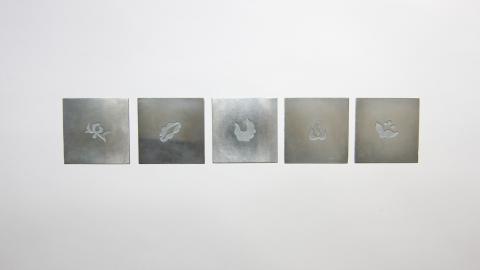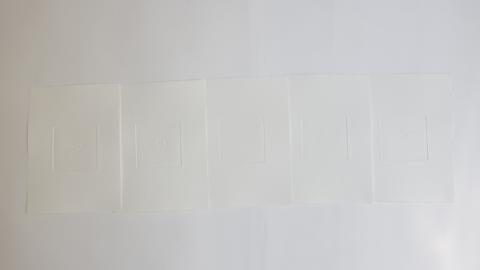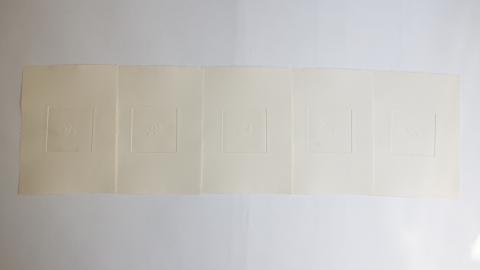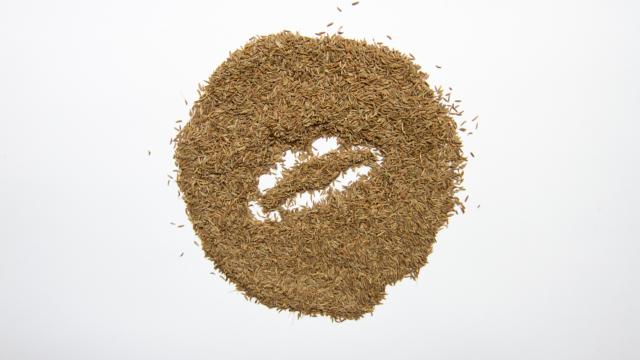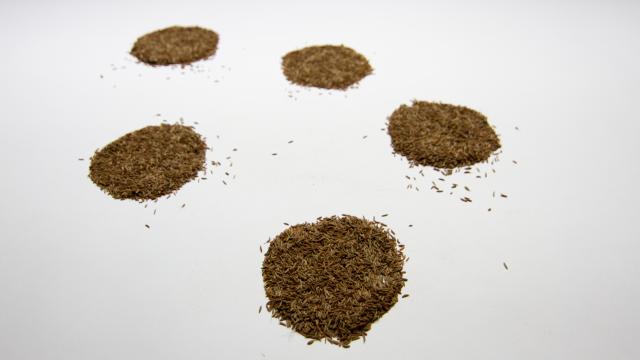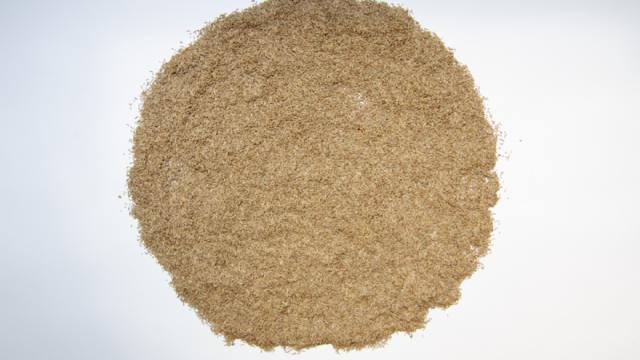METHODS
/PROCESS
/MATERIALS
While exploring beyond Camberwell, I visited the UAL Material Library Collection and encountered silk-paj. A sheer, delicate textile so light and elusive it felt like a memory in motion, barely tangible. Drawn to its ephemeral quality, I began embroidering distortions of remembered shapes onto it with horsehair, combining two fragile materials that resist capture and fade into invisibility. Later, inspired by Mona Hatoum’s hair works, I wove strands of my own hair collected from my flat into the paj, creating a layered expression of bodily presence and the fleeting, unstable nature of memory, where I became subject, object, and trace of my own gestures and existence.
1: Human hair on white cotton fabric glued with PVA glue. 15 x 15 cm
After an induction to the etching workshop, I began experimenting with hard-ground etching, drawn to how shapes emerged through absence – material scraped by a needle to reveal delicate, intimate traces of fragmented memory. I later approached the process as contemplative and serial, producing almost invisible impressions embossed onto paper. Although, I briefly explored sand-blasting metal sheets, I became more interested in paper as skin. A surface where remembered shapes could appear as nearly invisible, inkless tattoos: quiet, ephemeral forms, shifting depending on my bodily distance. Here, misremembered motifs and remembered space blend in fragile, tactile gestures.
I become interested in caraway seeds, as dormant yet fertile carriers of our familial memory and rituals. As my focus shifts from fixed outcomes to the act of shaping and placing as a contemplative gesture, I become interested in ephemeral, living sculptures. These experiments engaged with the un-visible and the unfolding, holding space for becoming, transience, the immaterial within the material as a fertile filed of energy for continuation.
/PROCESS
/MATERIALS
Key interests: fragmentation; interstitiality; the remembered-misremembered-forgotten object; slippage between remembering and forgetting; memory as latent, elusive, residual, cyclical, and embodied; mapping a remembered space; traces of home; the weave; performative gestures; ritualised repetitive acts; presence in absence; material substructions; the immaterial in materials; living materials; continuity; visibility and invisibility; delicacy and fragility; becoming and unfolding; space as an action of movement.
At the start of Unit 2, I began exploring memory as a generative element, focusing on drawing from fragmented, remembered impressions, rather than reproducing exact motifs of my Mother’s Kalocsa embroidery and my Father’s water processing facility exploring slippage between remembering, misremembering and forgetting.
In my material experiments, I gravitated toward an intimate, hand-held scale – work I could hold close stitched with gestures of repair and reassembly, passed down by my Mother, like embroidery, and applique. I chose square forms, miniature versions of the 5x5meter floorplan of my Mother’s kitchen –familial, portable, mutable spaces of memory that can travel with me.
1: Satin stitch hand-embroidery. White cotton thread, white cotton fabric. 10 x 10 cm
I was drawn to materials that embody memory, like clay woven with braids of human hair and satin ribbon, echoing our familial ritual of my Mother’s hands braiding my hair. A tender choreography, where the immaterial lingers somewhere between the patterned repetition of touch, gesture and closeness. I was interested in the weave as something almost beyond making, reflecting my intimate practice of ritual patterning, where fragility, fragments and the unfinished speak to a quite becoming and unfolding.
1: Leather imprints on matt white glazed white stoneware clay, stitched with red satin ribbon 10 x 10 x 0.6 cm
The technical workshops allowed me to explore the presence and material activation of sandblasted glass. I was interested in the interplay of presence within absence in material substructions, as sand blown by air ate away the surface of the glass – where what was missing created space for misremembered shapes to become visible, embodying the concept ‘when empty is full’. For me, glass also holds the presence of the interstitial space being connected both to the intimate and to the public, to the self and to the collective at the same time.
I expanded my materials by incorporating elements like braids, half-forgotten embroidery motifs, red satin ribbons, patchwork, weave, and horse hair to reconnect with my familial and Hungarian folk heritage. These materials and gestures serve as inclusive acts of gathering emotionally and culturally, centring my family as both subject and source. By weaving horse hair and satin ribbons with glass fragments, I created ceremonial offerings, that link my personal world with the collective, sustaining an evolving search for home and connection through ritualised, material making.
During a period of illness, I returned to hand-embroidery from bed as a meditative act of making. An intimate, convergent practice that supported healing, where each fragment emerged daily alongside my recovery, experimenting with memory as a tactile repository of healing and a space of connection between body, mind and object as operated by remembering and performative gesture.
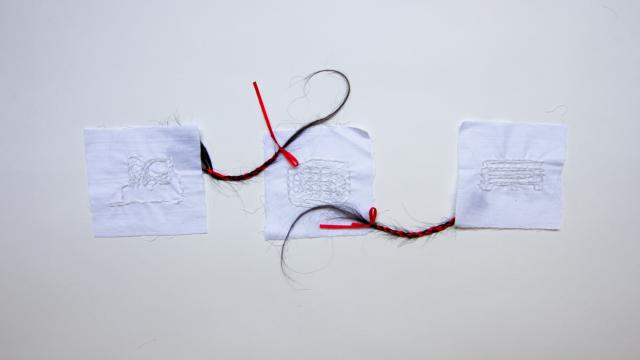 3 pieces of stem-outline hand-embroidery (15 x 15 cm each). White cotton thread, white cotton fabric, braided human hair, red satin ribbon. Dimensions variable.
3 pieces of stem-outline hand-embroidery (15 x 15 cm each). White cotton thread, white cotton fabric, braided human hair, red satin ribbon. Dimensions variable.
I become interested in exploring how raw white stoneware clay becomes a metaphorical blank slate – silent, tactile, and rooted in the raw earth to reflect the meditative, residual, and cyclical qualities of memory. I experimented with repetitive, performative gestures to access emotional value through half-forgotten forms, allowing imprints and surfaces to hold traces of time and touch. My use of wave, a technique passed down by my Mother, became a quite homage to inherited practices and the continuity of connection.
Following a group crit with Yu-Chen Wang, I began to expand my practice beyond object making to explore how photography could capture the intersection of space-memory-perception through fractured, in-between realities. Influenced by a critical reflection seminar with Anna Bunting Branch, I became interested in memory as situational knowledge — shaped by position, relation and intention. Asking questions like: Where do I see from? Who do I see with? What do I see for? This led me to consider space as fluid and responsive, a container formed through bodily movement and gesture, where fragmentation becomes a generative mode of unfolding. I placed transparent glass beneath my window and photographed them over the course of a Saturday, tracing how they shifted in response to my bodily gestures, light, and time unfolding in London.
At the start of Unit 2, I began exploring memory as a generative element, focusing on drawing from fragmented, remembered impressions, rather than reproducing exact motifs of my Mother’s Kalocsa embroidery and my Father’s water processing facility exploring slippage between remembering, misremembering and forgetting.
In my material experiments, I gravitated toward an intimate, hand-held scale – work I could hold close stitched with gestures of repair and reassembly, passed down by my Mother, like embroidery, and applique. I chose square forms, miniature versions of the 5x5meter floorplan of my Mother’s kitchen –familial, portable, mutable spaces of memory that can travel with me.
1: Satin stitch hand-embroidery. White cotton thread, white cotton fabric. 10 x 10 cm
2: Needle punched holes on white cotton fabric. 10 x 10 cm
3: Applique. Pink cotton thread, white cotton fabric. 10 x 10 cm
4: Satin stitch hand-embroidery. White cotton thread, white cotton fabric. 10 x 10 cm
5: Applique. White cotton thread, white cotton fabric. 10 x 10 cm
6: Hand-stitched steel wire mesh. 10 x 10 cm
7-8-9: Stem outline hand-embroidery. White-red-black cotton thread, white cotton fabric. 10 x 10 cm.
10: Hand-embroidered and hand-stitched embroidery. Canvas, white cotton thread 10 x 10 cm
11: Stem outline hand-embroidery. White cotton thread, white cotton fabric. 10 x 10 cm
I was drawn to materials that embody memory, like clay woven with braids of human hair and satin ribbon, echoing our familial ritual of my Mother’s hands braiding my hair. A tender choreography, where the immaterial lingers somewhere between the patterned repetition of touch, gesture and closeness. I was interested in the weave as something almost beyond making, reflecting my intimate practice of ritual patterning, where fragility, fragments and the unfinished speak to a quite becoming and unfolding.
1: Leather imprints on matt white glazed white stoneware clay, stitched with red satin ribbon 10 x 10 x 0.6 cm
2: Leather imprints on matt white glazed white stoneware clay, stitched with white cotton thread 10 x 10 x 0.3 cm
3: Leather imprints on transparent glazed white stoneware clay, stitched with white cotton thread. 10 x 10 x 0.6 cm
4: Leather imprints on glossy white glazed white stoneware clay, stitched with braided human hair 10 x 10 x 0.6 cm
The technical workshops allowed me to explore the presence and material activation of sandblasted glass. I was interested in the interplay of presence within absence in material substructions, as sand blown by air ate away the surface of the glass – where what was missing created space for misremembered shapes to become visible, embodying the concept ‘when empty is full’. For me, glass also holds the presence of the interstitial space being connected both to the intimate and to the public, to the self and to the collective at the same time.
I expanded my materials by incorporating elements like braids, half-forgotten embroidery motifs, red satin ribbons, patchwork, weave, and horse hair to reconnect with my familial and Hungarian folk heritage. These materials and gestures serve as inclusive acts of gathering emotionally and culturally, centring my family as both subject and source. By weaving horse hair and satin ribbons with glass fragments, I created ceremonial offerings, that link my personal world with the collective, sustaining an evolving search for home and connection through ritualised, material making.
During a period of illness, I returned to hand-embroidery from bed as a meditative act of making. An intimate, convergent practice that supported healing, where each fragment emerged daily alongside my recovery, experimenting with memory as a tactile repository of healing and a space of connection between body, mind and object as operated by remembering and performative gesture.
 3 pieces of stem-outline hand-embroidery (15 x 15 cm each). White cotton thread, white cotton fabric, braided human hair, red satin ribbon. Dimensions variable.
3 pieces of stem-outline hand-embroidery (15 x 15 cm each). White cotton thread, white cotton fabric, braided human hair, red satin ribbon. Dimensions variable. I become interested in exploring how raw white stoneware clay becomes a metaphorical blank slate – silent, tactile, and rooted in the raw earth to reflect the meditative, residual, and cyclical qualities of memory. I experimented with repetitive, performative gestures to access emotional value through half-forgotten forms, allowing imprints and surfaces to hold traces of time and touch. My use of wave, a technique passed down by my Mother, became a quite homage to inherited practices and the continuity of connection.
Following a group crit with Yu-Chen Wang, I began to expand my practice beyond object making to explore how photography could capture the intersection of space-memory-perception through fractured, in-between realities. Influenced by a critical reflection seminar with Anna Bunting Branch, I became interested in memory as situational knowledge — shaped by position, relation and intention. Asking questions like: Where do I see from? Who do I see with? What do I see for? This led me to consider space as fluid and responsive, a container formed through bodily movement and gesture, where fragmentation becomes a generative mode of unfolding. I placed transparent glass beneath my window and photographed them over the course of a Saturday, tracing how they shifted in response to my bodily gestures, light, and time unfolding in London.
While exploring beyond Camberwell, I visited the UAL Material Library Collection and encountered silk-paj. A sheer, delicate textile so light and elusive it felt like a memory in motion, barely tangible. Drawn to its ephemeral quality, I began embroidering distortions of remembered shapes onto it with horsehair, combining two fragile materials that resist capture and fade into invisibility. Later, inspired by Mona Hatoum’s hair works, I wove strands of my own hair collected from my flat into the paj, creating a layered expression of bodily presence and the fleeting, unstable nature of memory, where I became subject, object, and trace of my own gestures and existence.
1: Human hair on white cotton fabric glued with PVA glue. 15 x 15 cm
2: Horse hair on white cotton fabric glued with Textile glue. 15 x 15 cm
3: Hand-embroidered horse hair on white cotton fabric. 15 x 15 cm
4: Hand-embroidered horse hair on white silk-paj. 15 x 15 cm.
After an induction to the etching workshop, I began experimenting with hard-ground etching, drawn to how shapes emerged through absence – material scraped by a needle to reveal delicate, intimate traces of fragmented memory. I later approached the process as contemplative and serial, producing almost invisible impressions embossed onto paper. Although, I briefly explored sand-blasting metal sheets, I became more interested in paper as skin. A surface where remembered shapes could appear as nearly invisible, inkless tattoos: quiet, ephemeral forms, shifting depending on my bodily distance. Here, misremembered motifs and remembered space blend in fragile, tactile gestures.
I become interested in caraway seeds, as dormant yet fertile carriers of our familial memory and rituals. As my focus shifts from fixed outcomes to the act of shaping and placing as a contemplative gesture, I become interested in ephemeral, living sculptures. These experiments engaged with the un-visible and the unfolding, holding space for becoming, transience, the immaterial within the material as a fertile filed of energy for continuation.
